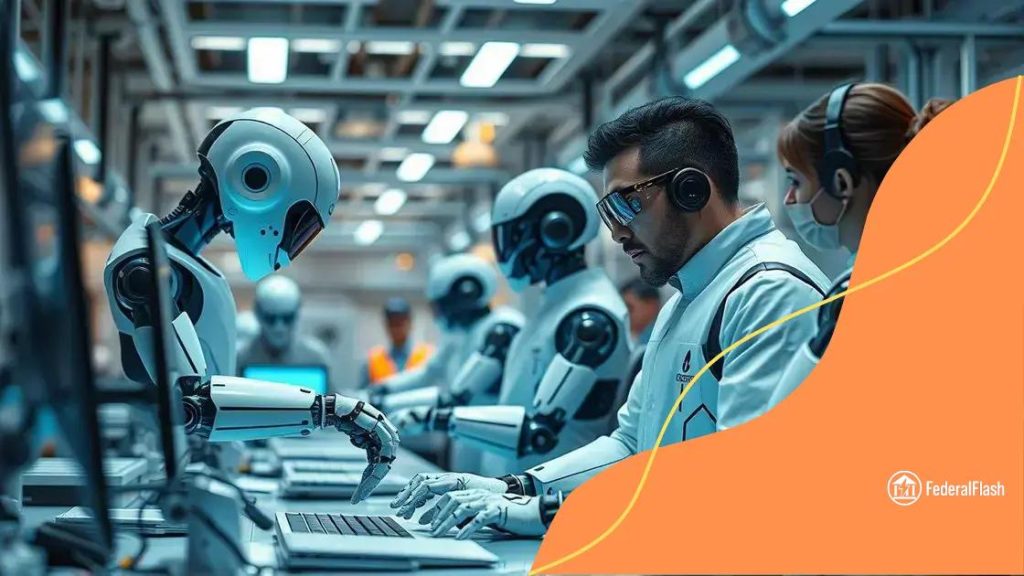Examining the impact of automation on the future of work

Anúncios
Automation significantly impacts the future of work by transforming job roles, enhancing productivity, requiring new skills, and improving work-life balance through technology collaboration.
Examining the impact of automation on the future of work invites us to consider how technology is transforming industries. Have you thought about what this means for your job or career path? This article delves into the benefits and challenges of automation, sparking a conversation about our evolving work environments.
Anúncios
Understanding automation and its relevance
Understanding automation and its relevance is essential in today’s rapidly changing workforce. Automation involves the use of technology to perform tasks that were traditionally carried out by humans. As industries evolve, understanding this change helps individuals and businesses adapt effectively.
Technology is transforming how we work, making processes quicker and more efficient. Automation plays a crucial role, enabling companies to improve productivity and reduce costs. It’s not just about machines replacing humans; it’s also about enhancing human capabilities and focusing on more complex tasks.
The types of automation
There are various forms of automation that can impact workplaces:
Anúncios
- Robotic Process Automation (RPA) – Software robots handle repetitive tasks.
- Industrial Automation – Machines automate physical processes in manufacturing.
- Office Automation – Streamlining office tasks through digital tools.
- Intelligent Automation – Combining AI with automation for smarter solutions.
As we explore these types, it’s vital to note that they not only save time but also offer a competitive edge. Businesses implementing automation can shift their focus towards innovation and strategy. This leaves employees to handle creative and high-value tasks, enhancing job satisfaction and engagement.
However, the transition to automated systems requires careful planning. Organizations must invest in training for their workforce, ensuring that employees can effectively interact with new technologies. This upskilling is critical because it empowers workers to thrive in an increasingly automated environment.
The relevance of automation today
In today’s marketplace, the relevance of automation cannot be overstated. Companies that embrace these technologies tend to outperform those that resist change. Automation helps in responding swiftly to market demands, leading to better customer experiences.
Moreover, automated systems gather and analyze data faster than manual processes, allowing companies to make informed decisions quickly. This adaptability is crucial in a world where consumer preferences shift rapidly and competition is fierce.
The benefits of automation in the workplace
The benefits of automation in the workplace are transforming job environments in remarkable ways. Automation can streamline tasks, improve efficiency, and enhance productivity. By implementing automated systems, companies can save time and resources while allowing employees to focus on more important work.
One of the greatest advantages of automation is its ability to handle repetitive tasks. This frees up employees to engage in creative and strategic activities that require human insight. For instance, customer service inquiries can be managed through chatbots, which operate around the clock. Employees can then concentrate on resolving complex issues and providing personalized service.
Increased Efficiency
Automation leads to significant gains in efficiency. Processes that once took hours can now be completed in minutes. This rapid turnaround provides businesses with a competitive edge. Some key points include:
- Faster processing times for tasks such as data entry and report generation.
- Reduced errors since machines follow precise instructions.
- Consistent output, ensuring quality control remains high.
- Enhanced scalability to manage larger workloads without additional staff.
Additionally, automation minimizes downtime. Automated systems can monitor operations continuously and perform routine maintenance without interrupting workflow, allowing businesses to operate smoothly.
Cost Savings
Another benefit of automation is the potential for cost savings. By reducing the need for manual labor in repetitive tasks, companies can lower labor costs. This efficiency can lead to:
- Lower operational expenses as automated systems require less oversight.
- Decreased training costs since new employees can quickly learn the system.
- Increased profitability from improved productivity and reduced errors.
In summary, the integration of automation in the workplace not only boosts productivity but also supports employee satisfaction by freeing them from mundane tasks. Working alongside automation allows individuals to pursue more fulfilling work.
How automation is reshaping job roles

How automation is reshaping job roles is a vital topic as industries evolve. As automation technologies advance, traditional job roles are changing significantly. Many tasks once performed by humans are now being executed by machines and algorithms. This shift is not just about job loss; it’s also about creating new opportunities.
One of the biggest changes automation brings is the transformation of existing roles. Employees are now required to adapt to new technologies, which can lead to enhanced skill sets. For instance, someone working in manufacturing may shift from assembly line duties to overseeing automated equipment. This change helps workers develop valuable technical skills that increase their marketability.
The emergence of new roles
Automation is not only changing current jobs but also creating new roles that didn’t previously exist. Some examples of these emerging jobs include:
- Data analysts who interpret data generated by automated systems.
- Automation specialists who design, implement, and maintain automated processes.
- AI ethicists who ensure that automation aligns with ethical standards.
- Robotic maintenance technicians who repair and maintain automated machines.
With these new roles comes the necessity for ongoing training and education. Companies must invest in their employees to help them transition smoothly into these new positions. Upskilling programs can enhance workers’ capabilities and ensure they remain relevant in an automated job market.
Collaboration between humans and machines
Another essential aspect of how automation is reshaping job roles is the increased collaboration between humans and machines. Rather than replacing workers, automation often complements human abilities. For instance, automated systems can manage data entry, while employees focus on strategy and decision-making. This synergy can lead to a more productive and efficient workplace.
As jobs continue to evolve, it is crucial for both workers and employers to embrace change. Understanding how automation will impact roles can help workers stay prepared. Ultimately, this transformative process can lead to a workforce that is not only more skilled but also more innovative.
Challenges posed by automation
Challenges posed by automation are an important aspect to consider as technology continues to advance. While automation brings many benefits, it also introduces difficulties that organizations and employees must face. Understanding these challenges can help prepare for a successful transition into more automated environments.
One major challenge is the potential loss of jobs. As machines take over repetitive tasks, some positions may become obsolete. This can lead to unemployment, particularly for low-skilled workers. While new roles may emerge, the transition can be difficult for individuals who need to adapt to changing job requirements.
Skills Gap
Another significant issue is the skills gap. Automation requires different skills than traditional jobs. Many employees may not have the necessary training to work alongside new technologies. This lack of skills can hinder productivity and create frustration among workers. Companies need to address this by investing in training programs. These programs should focus on:
- Upskilling existing workers to help them adapt to new technologies.
- Reskilling workers for entirely new roles created by automation.
- Collaborating with educational institutions to prepare future employees for the automated workforce.
The rapid pace of change in technology also creates challenges. Companies must continuously update their systems and processes, which can be costly and time-consuming. Staying competitive means being agile and willing to adapt quickly. This can strain resources, especially for small to medium-sized businesses.
Ethical Considerations
Moreover, automation raises ethical questions as well. Issues such as data privacy, surveillance, and decision-making bias become prominent when machines handle sensitive tasks. Businesses must ensure that their automated processes are fair and transparent. They need to develop guidelines that address these concerns while fostering trust among employees and customers.
In summary, the challenges posed by automation encompass job displacement, skills gaps, rapid technological changes, and ethical dilemmas. Recognizing these challenges is crucial for guiding organizations and individuals through the evolving landscape of work.
The future of work in an automated world
The future of work in an automated world is a rapidly evolving topic that intrigues many. As automation technology advances, it reshapes how companies operate and how employees perform their tasks. This change is not just about machines taking over jobs; it’s also about creating a new workplace landscape where humans and technology coexist.
The workplace of the future will likely be characterized by a blend of human intelligence and automated systems. Employees will work alongside advanced tools that enhance their productivity and creativity. For example, in areas like customer service, chatbots may handle simple inquiries, giving human agents more time for complex interactions. This partnership can lead to better customer experiences and increased job satisfaction.
Increased Flexibility
Another significant aspect of the future work environment is flexibility. Remote work and flexible hours are becoming more standard, and automation supports this shift. With tools that enable communication and collaboration from anywhere, employees can manage their time more effectively. Companies can adapt to a global workforce by utilizing automation to facilitate operations across different regions.
Moreover, the demand for skilled workers will continue to rise. As job roles evolve, employees need to adapt their skills and embrace lifelong learning. Continuous education and training will be essential for staying competitive in the job market. Organizations that support skill development will not only benefit from a more prepared workforce but also improve employee loyalty and retention.
Work-Life Balance
Automation can also lead to improved work-life balance. By automating repetitive tasks, employees can focus on work that is more engaging and fulfilling. This shift can reduce stress and promote well-being in the workplace. As employees take on more meaningful tasks, they may find greater job satisfaction and motivation.
However, challenges remain. Organizations must address issues of equity and access to technology. Ensuring that all employees have the tools and support they need will be crucial in creating a fair and inclusive work environment. With the right approach, the future of work in an automated world can be promising, paving the way for innovation and growth.
FAQ – Frequently Asked Questions about Automation and the Future of Work
How is automation changing job roles?
Automation is reshaping job roles by taking over repetitive tasks, allowing employees to focus on more complex and creative aspects of their jobs.
What skills will be important in an automated world?
As jobs evolve, skills in technology, data analysis, and adaptability will be crucial for employees to thrive alongside automation.
Can automation improve work-life balance?
Yes, by automating routine tasks, employees can engage in more meaningful work and enjoy greater flexibility, leading to improved work-life balance.
What should companies do to prepare their workforce for automation?
Companies should invest in training and continuous education programs to help employees adapt to new technologies and embrace the changes in their roles.